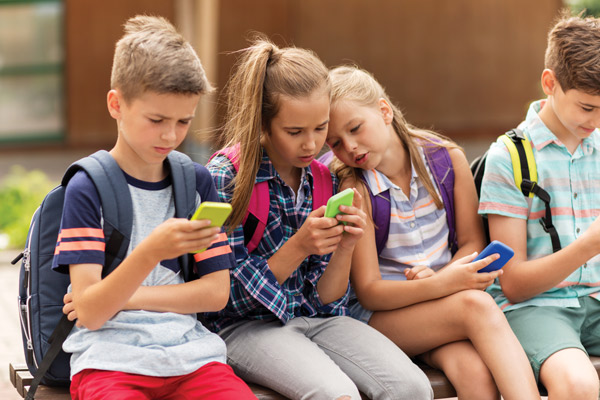How young is too young for an iPhone?
Elementary school kids are mature enough to embarrass high schoolers

February 5, 2019
As a 10-year-old, I looked forward to coming home every day from school so I could play Flappy Bird on my father’s iPod. It was small and blockish, but I was thrilled and in utter awe just being able to hold it. Never would I have guessed that five quick years later, young students would be introduced to cell phone usage in classrooms.
According to EdTechReview, 54% of 21st century kids begin using mobile devices regularly between the ages of 5 and 8. My own cell phone journey started at 8 years old with the smallest, cheapest slide phone possible. I walked to and from school every day between third and eighth grade and needed a way to get in contact with my parents about my ride home from school. The slide phone was a gift for my birthday and it came with two features: limited texting and limited calls. It didn’t, at the time, affect my school performance or my relationship with friends and family. But as the years passed, I became more addicted to my phone.
In the fall of 2014, I got my first iPhone. It was 6th grade and a few of my friends had them. Middle school went on as usual for the next two years, but in eighth grade, phones started to become a classroom nuisance. Seeing my peers entertained by their own phones, I started using mine occasionally in class. Near the end of the school year, teachers began taking phones from students for using them in class. However, entering my freshman year at Millard West, my teachers started collecting our phones as a precautionary measure to keep us off of them during class. At this time in 2017, Digital Trends claimed 82% of teenagers owned a cell phone.
Skip forward a few more years and suddenly 11 out of 24 fifth graders in Ackerman teacher Michelle Ferguson’s language arts class have a cell phone. When it comes to technology in her classroom, Ferguson recognizes both the advantages and disadvantages.
“There is always a concern that they are playing on the device,” Ferguson said. “They [phones] can be used for school things, but because we have little control on what they have access to on their phones, I prefer for them to keep them put away during school hours.”
In recent years, elementary schools have seen a huge advance in technology. Since students have come back from Winter Break, they have been using their own classroom set of iPads. The teacher has access to see what’s on every kid’s screen, and has the ability to lock children out of the iPad if the device is being used inappropriately.
The use of technology with classroom work is called blended learning and combines the positive aspects of technology with the the positive aspects of a traditional classroom style. Students seem to like this because they recognize that technology can be fun, but furthermore, it has a purpose other than entertainment. High school students are barely able to manage their phones during school hours, but yet young children have the same temptation and are better at knowing when is an appropriate time to be using technology and when it’s best to keep it put away.
“One of my most common things I say is, ‘Is it a tool or a toy?’” Ferguson said. “If it’s a tool, then we use it in class. A toy? Put it in your backpack.”
Elementary school children are able to handle temptations better than the typical teenager. Phones are an immense issue, especially at Millard West. Three of my four teachers collect my phone during class so it doesn’t become a problem. However, phones aren’t collected in elementary schools because there’s no need for it. These children know how to use technology to their advantage and keep their personal devices put away when they’re not being used.
“Overall they [phones] don’t pose a problem,” Ferguson said. “They keep them in their backpacks and are supposed to have them turned off during the day.”
When it comes to the temptation of owning a phone, it simply depends on the individual. Some are better at handling the responsibility of phones from a younger age, but others need to wait until middle school. However, as demonstrated in Ferguson’s classroom, phones aren’t a current issue at the elementary level and provide very minimal distraction in classrooms.
The amount of respect elementary school students deserve is outstanding. These children, unlike high school students, don’t need strict rules to be hammered into their heads to know when is and when isn’t an appropriate time to use their cell phones during the day. These children will be much more prepared for the real world than our generation was due to the driving factor that they’re able to use technology as a tool instead of a toy. It’s almost embarrassing how simply phones can be handled in elementary schools, but how big of an issue they are at the high school level.






